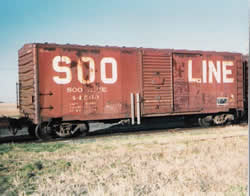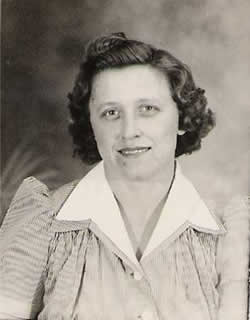Anamoose Stock Yards in the 20s & 30s
|
||
Back in the 120s and 30s we had a stockyard on the east end of the elevator line in Anamoose. The Soo Line Railroad Company built them all along their line as most of the livestock was shipped by train in the early years. Most all of the small towns on the Soo had stockyards. The cattle cars were built almost like a huge crate on wheels. There were a lot of slats for air conditioning. As I recall, the cattle cars were painted a red-rest color. They were easy to spot. We kids knew they were going to unload cattle when we saw and heard the animals as they were being put on the loading track at the yards. My father was section foreman in Anamoose for 44 years so we kids could just about tell what was going on with his railroad. We knew when he was to unload cattle. He hated the whole procedure. He said he was a railroad man, not a farmer. Nevertheless, he had to get his crew together, no matter what hour of the day or night it happened to be when a cattle train came into town. If it was after his regular working hours, he was a very upset man. He could swear in four different languages which made it exciting for all who were within hearing distance. Animals being shipped by the railroad cars could only be confined in the cars for a 36 hour time period. Then they had to be unloaded into a stockyard where they were rested for 12 hors before they were reloaded to head east again. While at the stockyards, the section crew had to put fresh hay down for them from the feeding racks that ran along the north end of the pens. That part was built much higher than the rest of the yard. It was also covered, giving some shade to the animals. There was a well on the north side of the stockyards. In the earlier years, the men pumped the water by hand. Later they put a little motor on the well. All of this was a lot of extra work for Dad and his crew. There was a huge sand pile close by the stockyards near the tracks. We kids had a ball playing on it until the depot agent or one of the elevator crew spotted us. We were quickly sent on our way. The sand was used to spread inside the cattle cars so the animals wouldn’t slip and fall. Breaking a leg meant the loss of a cow and money. Sometimes they would have a double shipment where they had a partition in about the center of the car holding both cattle and pigs. That always caused a lot of excitement if it was during the daytime because we kids could then go down and watch. We’d hang on the wooden fence like so many box elder bugs clinging to a tree. For some reason, by the time the pigs were unloaded in their separate pens, everyone in town knew they were unloading pigs as they are a noisy animal. When there were about 20-30 of them together, being prodded here and there, the squalling was deafening. In the ‘30s when the weather was so hot with no cooling even in the evening, it was hard on the animals in such close quarters. Pigs can’t stand much heat so they would have to hose them down at certain intervals of the trip to market. For some reason or another, all of this just fascinated the city kids to see so many animals in one place. We would run all over the stockyards on the top plank which was about six inches wide. We actually played tag up there. Of course that was cut short when the depot agent, Steve Law, would spot us. Or sometimes it was Mr. Hackart who worked at the elevator. Sometimes it was S.A.Perry who ran the Anamoose Flour Mill,which was at the location where Mrs. Sommerfield’s house now stands.
Back then it seemed as if anyone was within his rights to discipline anyone else’s children regardless of who they were or where they were or what they were doing. I liked and respected all three men I have mentioned here, and we didn’t give them any back talk. We took off when they asked us to leave, only to return when everyone had simmered down again. I remember one time when there were two little lambs that were being trampled by the older sheep. They took them off the car. One died right away, but my sister Katie begged to take the one still alive home with her. She nursed it back to health. One Sunday it followed her to church. The little hooves beating out a drum sound up the main aisle. The priest politely asked her to take her lamb home. I don’t remember when they tore down the old stockyards, but even now when I take what I call “my railroad hikes” I can still picture it all. The well, the big scale to weigh cattle, the different pens, the large gates, the long loading ramps that we had so much fun chasing each other right into the empty boxcar, the wooden fences. It’s all there!
|

